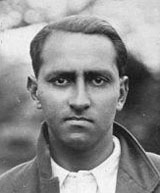The 21st-century coaching book
Simon Briggs
|
|

|
Out on the field, even in 1952, things were a little more flexible. Denis Compton, the book's principal model, was a master of the sweep - a shot MCC appeared not to recognise. Yet the dominance of Test cricket, with the draw common and timeless Tests not consigned to history, fostered an essential conservatism among batsmen. For most of them, the first concern was to minimise risk; run-scoring came a long way down the agenda.
Fifty years on, the world's bowlers find themselves facing a quite different challenge. One-day cricket, with its improvised twists and pre-emptive strikes, is the paymaster now, and its values have spread. Two of the three most prolific Test batsmen of 2002, Michael Vaughan and Matthew Hayden, were both openers, but not the eggshell-treaders of old. This pair would rather put dents in the new ball than see it off.
Something has happened to the players' inbuilt coaching manuals since 1952, something that Charles Darwin might have recognised. And even as this addendum to the batting handbook was being compiled, the pace of change kept rising, driven on by the sheer volume of top-level cricket.
Whether he is bowling or batting, the modern player needs to be quick-witted and adaptable. Predictability is soon overtaken. Even Sachin Tendulkar, probably the world's leading exponent of classical technique, has found that artistry is not enough. Harried by opposition strategists armed with video evidence, he has proved his greatness by developing new weapons of his own. In contrast to the reliably orthodox Brian Lara, Tendulkar is often first to try an unfamiliar stroke. And thanks to his insatiable work ethic, he usually ends up playing it better than anyone else.
The uppercut
We start with one of Tendulkar's specialities, a stroke that has kept evolving
since South Africa's Eddie Barlow first copyrighted it in the early 1960s.
Despite the enthusiastic patronage of Tony Greig and Alan Knott, who
used it against the bounce of Lillee and Thomson in 1974-75, the uppercut
remained something of an oddity until the 1996 World Cup, where Sanath
Jayasuriya audaciously attacked the new ball inside the first 15 overs.
With the fast bowlers finding lift, and the field up inside the circle, the diminutive Jayasuriya reversed the advice of the coaching manual, which sermonises in bold type on the "importance of coming down on the ball from above". Instead, he leant back and whirled his bat like a hammer-thrower beginning his first revolution. To the astonishment of several fielding sides, the ball kept disappearing over wide third man for six.
Left-handed batsmen are always going to have an advantage playing this stroke, as most balls they face are already slanting across them in the right general direction. Though much taller, Hayden and Adam Gilchrist have both made plenty of capital from their own versions of the Jayasuriya slash. But Gilchrist has also mastered an alternative form, in which the ball is simply cuffed over the slips with the gentle but precise assistance that a football goalkeeper uses to tip a high shot over the bar
. This variant is likely to be seen more and more now that bouncers have been brought back into the one-day game. For Tendulkar, it functions as the perfect riposte to the bouncer aimed at the point of the right shoulder - a tactic designed to make the batsman hook in the air. Instead of stepping in behind the ball, he leans back far enough to get his body out of the way, then flips his bat up like a cook on pancake day. The ball sails over the cordon into the acres of space beyond third man's left hand. This shot is bad news for captains who put their fast bowlers out to pasture.
The reverse sweep
|
|

|
Duleepsinhji's opponents may never have seen the shot before, but they instinctively knew it was a transgressive stroke. In its most common form, it combines a right-hander's body position - left foot forward, right knee on ground, right hand below left on the handle - with a left-hander's horizontal swing of the bat, which moves clockwise from three o'clock to nine, sweeping the ball to third man: cricket's equivalent of cross-dressing.
This flagrant disregard for the first rule of Fred Trueman - cricket is a sideways-on game - explains why the reverse sweep has been treated with suspicion. The stroke's most famous moment came when the England captain Mike Gatting bungled it catastrophically during the 1987 World Cup final. But it was rehabilitated in the early 1990s thanks to Warwickshire's captain-coach team, Dermot Reeve and Bob Woolmer.
Their tactics were a response to the challenges thrown up by off-spinners in one-day cricket. If a bowler could sustain a good length, he could wheel away to a 3-6 on-side field with no one behind square on the off side. Woolmer and Reeve reckoned the reverse sweep could be more than just a run-getter in itself. By forcing the fielding side to cover third man, it would open up gaps for more orthodox strokeplay to exploit.
With respect to Duleepsinhji, the reverse sweep is basically a creature of the last two decades. Having successfully percolated down to club level, it can now claim to be the most important batting innovation since the arrival of helmets. Among the professionals, though, the stroke is undergoing further development. Virender Sehwag, Damien Martyn and Andy Flower have all played it in Tests. Jonty Rhodes has pioneered the reverse pull, for use against shorter balls and quicker bowlers.
Most controversially, New Zealand's Craig McMillan has started switching his hands as well as his intended scoring area, so transforming himself from right-hander to left-hander as the ball comes down. This has implications for the lbw law, among other things. The ploy has already forced an amendment to the Laws, defining off and leg stumps according to the batsman's stance "at the moment the ball comes into play for that delivery". The reverse-sweep taboo has been well and truly broken.
The scoop
This is another new twist on an old standard. In the early 20th century,
an Australian undertaker-cum-wicket-keeper by the name of Hanson Carter
developed a novel alternative to the leg glance. As Christopher Martin-Jenkins
writes in his biographical dictionary of Test cricketers, Carter's
"chief delight was a stroke by which he lifted the ball over his left shoulder
just as a labourer shovels the dirt out of a drain he is digging".
We could call it the shovel, in Carter's honour, but that term has become associated with a subspecies of on-side deflections, so let's settle for the scoop. Pakistan's Moin Khan was a prime exponent of the stroke, using it to fine effect against Glenn McGrath in the 1999 World Cup. But while Moin's scoop was usually played off a good-length ball, with the aim of lofting it over the fine-leg boundary, the shot can also be a useful counter to the yorkers and low full tosses that dominate the final overs. To make this play, the batsman attenuates the stroke, bending his front knee and cocking his wrists like a tennis player punching a low forehand volley.
The scoop has produced two memorable moments. The first was in a one-day international at Perth in 2000-01 when Zimbabwe, chasing 303, needed 15 off the last over to beat Australia and Doug Marillier had just come in. Marillier had told his team-mates he would "probably sweep" McGrath. He did so first ball, moving over to the off and helping the ball past fine leg. After taking a two into the off side, he did it again third ball. The target was down to five off three. McGrath put his fine leg back and Zimbabwe managed only three singles to lose by one run, but the scoop became famous in southern Africa - as the Marillier.
A happier ending came in last summer's Benson and Hedges semi-final at Old Trafford. Warwickshire were the visitors, and after a seesawing match their No. 11, Neil Carter (what is it about men named Carter?), found himself walking to the wicket with one ball left and two runs needed. Most tailenders would have opted for a cow-shot, but when Glen Chapple fired in the usual full, straight ball, Carter, a left-hander, reached forward and flicked it over short fine leg's head for four.
The scoop relies on the bowler's pace, simply using an angled blade to deflect the ball past the infield. It is therefore rarely played against a spinner, and requires some courage. The body position tends to be low to the ground, as in a conventional sweep, with the eyes behind the line of the ball. If the bat fails to make contact, the result could be painful.
The ramp
A few more radical improvisers - notably Ryan Campbell, another
Australian wicket-keeper - have taken the shovel to its logical extension.
Instead of sending the ball over the left shoulder like a man throwing salt
for good luck, they manage to hoist it almost directly over their own heads
into the unguarded territory behind the wicket-keeper. This is the ramp.
When Campbell plays it, he ducks into a bizarre posture, with both
knees on the ground and his chest facing down the pitch. He positions
the bat with its toe pointing at the umpire, then brings it up towards his
face like a drawbridge. Though he needs a moment to scramble to his
feet, this hardly matters: the ball has usually scooted away for four.
There is a certain irony in the fact that the bat remains virtually straight,
in partial accordance with the textbook. Yet instead of taming the ball's
bounce, it is used to amplify it. If the ramp catches on, it could yet bring
the Under-10s' fielding position of long-stop into the professional game.
For now, though, it has to rate as the most exotic trick shot in the book.
The cross-court flick
How do you score off a straight ball that is what the professionals call
"back of a length"? A full-blooded pull is too risky unless the pitch is a
belter or your name is Aravinda de Silva. But Tendulkar and Hayden have
worked out a higher-percentage option: you offer a straight bat, as if to
force down the ground, then turn the wrists at the last second. The ball
tends to be heading just over the top of off stump, so the result looks like
a waist-high tennis forehand, whipped cross-court with top-spin.
It is hard to imagine this stroke being coached; it is best left to the elite, and even the world's top players have spent years developing their own takes on it. Tendulkar and his disciple, Sehwag, like to hang right back in the crease. Hayden, with his extra height, tends to step into the ball slightly. And then there is Vaughan, who has a technique all his own.
Less wristy than the others, Vaughan uses a kind of straight-batted pull to hit back-of-a-length balls wide of mid-on. Because he shuffles across the stumps as the bowler releases, he can get his back foot outside off stump and swivel his hips to face mid-wicket. The bat comes down like a straight forcing shot, with Vaughan's body position providing the angle.
When a batsman can work the ball so aggressively off the back foot, or drive it on the up, the bowler has virtually nowhere left to go. And that is good news for run-hungry spectators. Anyone who saw much Test cricket in 2002 will know that the one-day bug has infected the whole game. Cricket is the richer for it.
Simon Briggs, formerly assistant editor of Wisden Cricketers' Almanack, is deputy cricket correspondant of the Daily Telegraph.

